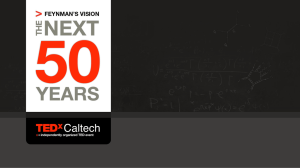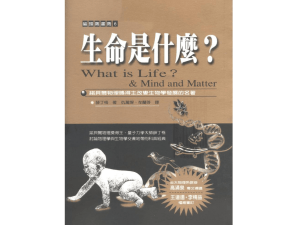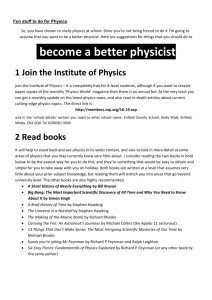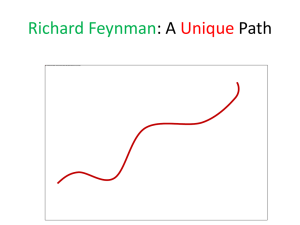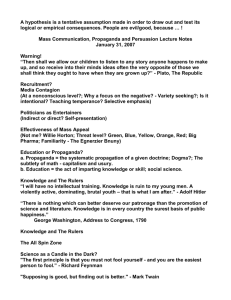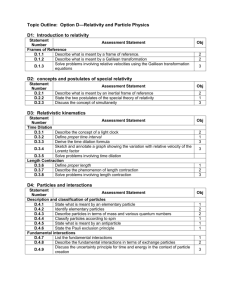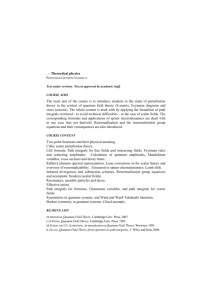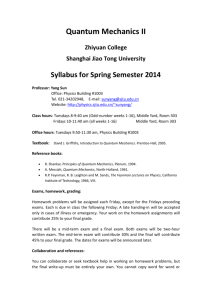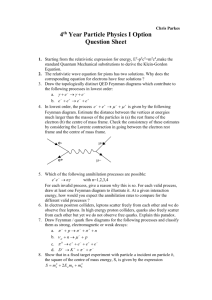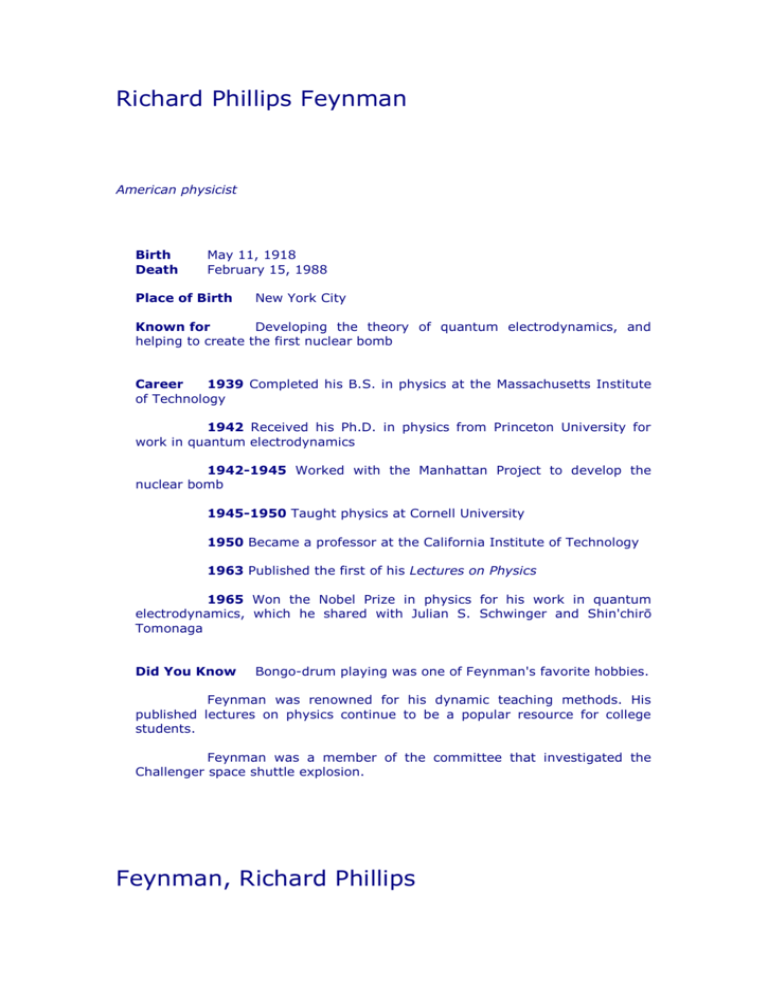
Richard Phillips Feynman
American physicist
Birth
Death
May 11, 1918
February 15, 1988
Place of Birth
New York City
Known for
Developing the theory of quantum electrodynamics, and
helping to create the first nuclear bomb
Career
1939 Completed his B.S. in physics at the Massachusetts Institute
of Technology
1942 Received his Ph.D. in physics from Princeton University for
work in quantum electrodynamics
1942-1945 Worked with the Manhattan Project to develop the
nuclear bomb
1945-1950 Taught physics at Cornell University
1950 Became a professor at the California Institute of Technology
1963 Published the first of his Lectures on Physics
1965 Won the Nobel Prize in physics for his work in quantum
electrodynamics, which he shared with Julian S. Schwinger and Shin'chirō
Tomonaga
Did You Know
Bongo-drum playing was one of Feynman's favorite hobbies.
Feynman was renowned for his dynamic teaching methods. His
published lectures on physics continue to be a popular resource for college
students.
Feynman was a member of the committee that investigated the
Challenger space shuttle explosion.
Feynman, Richard Phillips
Feynman, Richard Phillips (1918–1988), American physicist and Nobel laureate.
Feynman shared the 1965 Nobel Prize in physics for his role in the development
of the theory of quantum electrodynamics, the study of the interaction of light
with atoms and their electrons. He also made important contributions to the
theory of quarks (particles that make up elementary particles such as protons
and electrons) and superfluidity (a state of matter in which a substance flows
with no resistance). He created a method of mapping out interactions between
elementary particles that became a standard way of representing particle
interactions and is now known as Feynman diagrams. Feynman was a noted
teacher, a notorious practical joker, and one of the most colorful characters in
physics.
Feynman was born in New York City. As a child he was fascinated by mathematics
and electronics and became known in his neighborhood as “the boy who fixes
radios by thinking.” He graduated with a bachelor’s degree in physics from the
Massachusetts Institute of Technology (MIT) in 1939 and obtained a Ph.D. degree
in physics from Princeton University in 1942. His advisor was John Wheeler, and
his thesis, “A Principle of Least Action in Quantum Mechanics,” was typical of his
use of basic principles to solve fundamental problems.
During World War II (1939-1945) Feynman worked at what would become Los
Alamos National Laboratory in central New Mexico, where the first nuclear
weapons were being designed and tested. Feynman was in charge of a group
responsible for problems involving large-scale computations (carried out by hand
or with rudimentary calculators) to predict the behavior of neutrons in atomic
explosions.
After the war Feynman moved to Cornell University, where German-born
American physicist Hans Bethe was building an impressive school of theoretical
physicists. Feynman continued developing his own approach to quantum
electrodynamics (QED) at Cornell and then at the California Institute of
Technology (Caltech), where he moved in 1950.
Feynman shared the 1965 Nobel Prize in physics with American physicist Julian
Schwinger and Japanese physicist Tomonaga Shin’ichirō for his work on QED.
Each of the three had independently developed methods for calculating the
interaction between electrons, positrons (particles with the same mass as
electrons but opposite in charge) and photons (packets of light energy). The
three approaches were fundamentally the same, and QED remains the most
accurate physical
theory known. In Feynman's
space–time approach, he
represented physical processes with collections of diagrams showing how particles
moved from one point in space and time to another. Feynman had rules for
calculating the probability associated with each diagram, and he added the
probabilities of all the diagrams to give the probability of the physical process
itself.
Feynman wrote only 37 research papers in his career (a remarkably small
number for such a prolific researcher), but many consider the two discoveries he
made at Caltech, superfluidity and the prediction of quarks, were also worthy of
the Nobel Prize. Feynman developed the theory of superfluidity (the flow of a
liquid without resistance) in liquid helium in the early 1950s. Feynman worked on
the weak interaction, the strong force, and the composition of neutrons and
protons later in the 1950s. The weak interaction is the force that causes slow
nuclear reactions such as beta decay (the emission of electrons or positrons by
radioactive substances). Feynman studied the weak interaction with American
physicist Murray Gell-Mann. The strong force is the short-range force that holds
the nucleus of an atom together. Feynman’s studies of the weak interaction and
the strong force led him to believe that the proton and neutron were composed of
even smaller particles. Both particles are now known to be composed of quarks.
The written version of a series of undergraduate lectures given by Feynman at
Caltech, The Feynman Lectures on Physics (three volumes with Robert Leighton
and Matthew Sands, 1963), quickly became a standard reference in physics. At
the front of the lectures Feynman is shown indulging in one of his favorite
pastimes, playing the bongo drum. Painting was another hobby. In 1986
Feynman was appointed to the Rogers Commission, which investigated the
Challenger disaster—the explosion aboard the space shuttle Challenger that killed
seven astronauts in 1986. In front of television cameras, he demonstrated how
the failure of a rubber O-ring seal, caused by the cold, was responsible for the
disaster. Feynman wrote several popular collections of anecdotes about his life,
including “Surely You’re Joking Mr. Feynman” (with Ralph Leighton and Edward
Hutchings, 1984) and What do YOU Care What Other People Think? (with Ralph
Leighton, 1988).
Microsoft ® Encarta ® Reference Library 2003. © 1993-2002 Microsoft
Corporation. All rights reserved.
Feynman, Richard P.
born May 11, 1918, New York, N.Y., U.S.
died Feb. 15, 1988, Los Angeles, Calif.
in full Richard Phillips Feynman American theoretical physicist who was probably
the most brilliant, influential, and iconoclastic figure in his field in the post-World
War II era.
Feynman remade quantum electrodynamics—the theory of the interaction
between light and matter—and thus altered the way science understands the
nature of waves and particles. He was co-awarded the Nobel Prize for Physics in
1965 for this work, which tied together in an experimentally perfect package all
the varied phenomena at work in light, radio, electricity, and magnetism. The
other co winners of the Nobel Prize, Julian S. Schwinger of the United States and
Tomonaga Shin'ichirx of Japan, had independently created equivalent theories,
but it was Feynman's that proved the most original and far-reaching. The
problem-solving tools that he invented—including pictorial representations of
particle interactions known as Feynman diagrams—permeated many areas of
theoretical physics in the second half of the 20th century.
Born in the Far Rockaway section of New York City, Feynman was the descendant
of Russian and Polish Jews who had immigrated to the United States late in the
19th century. He studied physics at the Massachusetts Institute of Technology,
where his undergraduate thesis (1939) proposed an original and enduring
approach to calculating forces in molecules. Feynman received his doctorate at
Princeton University in 1942. At Princeton, with his adviser, John Archibald
Wheeler, he developed an approach to quantum mechanics governed by the
principle of least action. This approach replaced the wave-oriented
electromagnetic picture developed by James Clerk Maxwell with one based
entirely on particle interactions mapped in space and time. In effect, Feynman's
method calculated the probabilities of all the possible paths a particle could take
in going from one point to another.
During World War II Feynman was recruited to serve as a staff member of the
U.S. atomic bomb project at Princeton University (1941–42) and then at the new
secret laboratory at Los Alamos, N.M. (1943–45). At Los Alamos he became the
youngest group leader in the theoretical division of the Manhattan Project. With
the head of that division, Hans Bethe, he devised the formula for predicting the
energy yield of a nuclear explosive. Feynman also took charge of the project's
primitive computing effort, using a hybrid of new calculating machines and
human workers to try to process the vast amounts of numerical computation
required by the project. He observed the first detonation of an atomic bomb on
July 16, 1945, at Alamogordo, N.M., and, though his initial reaction was euphoric,
he later felt anxiety about the force he and his colleagues had helped unleash on
the world.
At war's end Feynman became an associate professor at Cornell University
(1945–50) and returned to studying the fundamental issues of quantum
electrodynamics. Inthe years that followed, his vision of particle interaction kept
returning to the forefront of physics as scientists explored esoteric new domains
at the subatomic level. In 1950 he became professor of theoretical physics at the
California Institute of Technology (Caltech), where he remained the rest of his
career.
Five particular achievements of Feynman stand out as crucial to the development
of modern physics. First, and most important, is his work in correcting the
inaccuracies of earlier formulations of quantum electrodynamics, the theory that
explains the interactions between electromagnetic radiation (photons) and
charged subatomic particles such as electrons and positrons (anti electrons). By
1948 Feynman completed this reconstruction of a large part of quantum
mechanics and electrodynamics and resolved the meaningless results that the old
quantum electrodynamic theory sometimes produced. Second, he introduced
simple diagrams, now called Feynman diagrams, that are easily visualized graphic
analogues of the complicated mathematical expressions needed to describe the
behaviour of systems of interacting particles. This work greatly simplified some of
the calculations used to observe and predict such interactions. (See also Feynman
diagram; quantum electrodynamics.)
In the early 1950s Feynman provided a quantum-mechanical explanation for the
Soviet physicist Lev D. Landau's theory of superfluidity—i.e., the strange,
frictionless behaviour of liquid helium at temperatures near absolute zero. In
1958 he and the American physicist Murray Gell-Mann devised a theory that
accounted for most of the phenomena associated with the weak force, which is
the force at work in radioactive decay. Their theory, which turns on the
asymmetrical “handedness” of particle spin, proved particularly fruitful in modern
particle physics. And finally, in 1968, while working with experimenters at the
Stanford Linear Accelerator on the scattering of high-energy electrons by protons,
Feynman invented a theory of “partons,” or hypothetical hard particles inside the
nucleus of the atom, that helped lead to the modern understanding of quarks.
Feynman's stature among physicists transcended the sum of even his sizable
contributions to the field. His bold and colourful personality, unencumbered by
false dignity or notions of excessive self-importance, seemed to announce: “Here
is an unconventional mind.” He was a master calculator who could create a
dramatic impression in a group of scientists by slashing through a difficult
numerical problem. His purely intellectual reputation became a part of the
scenery of modern science. Feynman diagrams, Feynman integrals, and Feynman
rules joined Feynman stories in the everyday conversation of physicists. They
would say of a promising young colleague, “He's no Feynman, but . . .” His fellow
physicists envied his flashes of inspiration and admired him for other qualities as
well: a faith in nature's simple truths, a skepticism about official wisdom, and an
impatience with mediocrity.
Feynman's lectures at Caltech evolved into the books Quantum Electrodynamics
(1961) and The Theory of Fundamental Processes (1961). In 1961 he began
reorganizing and teaching the introductory physics course at Caltech; the result,
published as The Feynman Lectures on Physics, 3 vol. (1963–65), became a
classic textbook. Feynman's views on quantum mechanics, scientific method, the
relations between science and religion, and the role of beauty and uncertainty in
scientific knowledge are expressed in two models of science writing, again
distilled from lectures: The Character of Physical Law (1965) and QED: The
Strange Theory of Light and Matter (1985).
James Gleick
Additional reading
James Gleick, Genius: The Life and Science of Richard Feynman (1992), is a
popular biography. Silvan S. Schweber, QED and the Men Who Made It (1994), is
a technical study of Feynman's work.
Article mentioning Feynman discoveries
The Experiment with Two Holes
Nobody really understands quantum physics, says scientist John Gribbin. Even to
advanced physicists, the question of why subatomic particles can act as both
waves and particles is still a puzzle. But the classic 19th-century “experiment with
two holes” is still the best way to illustrate how they behave that way. Gribbin’s
simple explanation of the experiment illuminates why quantum mechanics, which
provides the basis for modern physics and the scientific understanding of the
structure of matter, still challenges common sense.
The Experiment with Two Holes
By John Gribbin
Quantum physics is both mysterious and exciting. It describes a world of
subatomic particles where entities such as electrons can be both particle and
wave at the same time, and sometimes behave as if they are in two places at
once. Much of quantum physics runs counter to everyday common sense. And
yet, quantum physics underpins a great deal of modern science, from chemistry
and molecular biology to lasers, semiconductors, and nuclear power. In addition,
of course, it is at the heart of our understanding of the way forces operate
between electrically charged particles, or the forces that operate between quarks.
Some people find it frustrating that they cannot make sense of quantum physics,
and worry that somehow they are missing the point of what it is all about. But if
so they are in good company, and they can take comfort from the words of
Richard Feynman, the greatest physicist since Einstein, who said in his book The
Character of Physical Law, “I think I can safely say that nobody understands
quantum mechanics”—and this from a man who won the Nobel Prize for his work
in the subject. You shouldn't try to understand how quantum physics works,
Feynman taught us. All you can do is get a picture of what is going on. And the
best way to get that picture is from what he called “the experiment with two
holes,” but which most textbooks refer to as Young's double-slit experiment. This,
said Feynman on page 1 of the volume of his famous Lectures on Physics devoted
to
quantum
physics,
is
“a
phenomenon
which
is
impossible,
absolutely
impossible, to explain in any classical [that is, common sense] way, and which
has in it the heart of quantum mechanics. In reality, it contains the only mystery
… the basic peculiarities of all of quantum mechanics.” If you can come to terms
with the experiment with two holes, then you can come to terms with quantum
physics, since every other quantum mystery can always be put in context by
saying, “You remember the experiment with two holes? It's the same thing
again.”
Thomas Young, who gave the experiment its more formal name, was a British
physicist who worked in the early 19th century. His version of the experiment
involved light, and for a hundred years or so it was seen as proof that light is a
wave. The experiment may be familiar from school days. One pure color of light
(which is usually interpreted as meaning a single wavelength of light) is shone
through a hole in a screen, and on to another screen in which there are two
holes, or sometimes two long, narrow slits. Two sets of light waves spread out,
one from each of the holes, like ripples on a pond, and (just like two sets of
ripples produced by dropping two stones into a still pond simultaneously) they
interfere with one another. The result is that when the light arrives at the final
screen in the experiment, it makes a characteristic pattern of light and dark
stripes, called interference fringes. This is straightforward, schoolroom science,
from which you can even work out the wavelength of the light involved, by
measuring the spacing of the fringes. And one key feature of the interference
pattern is that it is brightest at a point on a line midway between the two holes,
where the two waves add together.
As Young summed up his work, in 1807, “the middle of the pattern is always
light, and the bright stripes on each side are at such distances that the light
coming to them from one of the apertures must have passed through a longer
space than that which comes from the other by an interval which is equal to the
breadth of one, two, three, or more of the supposed undulations [wavelengths],
while the intervening dark spaces correspond to a difference of half a supposed
undulation, of one and a half, of two and a half, or more.”
The trouble with this understanding of light emerged at the beginning of the 20th
century, when the work of first Max Planck (on black body radiation) and then
Albert Einstein (on the photoelectric effect) showed that light could be treated—
indeed, in some circumstances had to be treated—as if it were a stream of little
particles, light quanta, now known as photons.
The way particles pass through two holes in a wall is very different, in the
everyday commonsense world, from the way waves behave. If you stood on one
side of a wall in which there were two holes, and threw stones (or tennis balls) in
the general direction of the wall, some would go through each of the holes, and
they would make two piles on the other side of the wall, one behind each hole.
You certainly would not get one big pile of tennis balls, or rocks, halfway between
the two holes in the wall.
The discovery that light can behave like a wave or like a particle is an example of
wave-particle duality. By the 1920s it was clear that electrons, which were
traditionally regarded as particles, could also behave like waves, in another
example of wave-particle duality. Now, we know that in the Alice-in-Wonderlandlike quantum world all waves are particles, and all particles are waves. And we
can summarize decades of delicate probing of this central mystery of the
quantum world by describing what happens when individual quantum entities,
either electrons or photons, are fired, one at a time, through the experiment with
two holes.
It is important to stress that this really has been done, with both kinds of
quantum entity (and even with whole atoms). This is not some sort of
hypothetical thought experiment, but real physics which has been studied in
laboratories. The electron version of the experiment was carried out in 1987, by
Japanese researchers, and works like this.
When electrons are fired through a version of the experiment with two holes,
their arrival on the other side can be recorded on a detector screen like a
television screen. The special feature of this screen is that each electron makes a
spot of light on the screen, and the spot stays there as other electrons arrive,
each making its own spot, so that gradually they build up a pattern on the
screen. Each electron leaves a “gun” on one side of the experiment as a particle.
Each electron arrives at the detector on the other side as a particle, and makes
one small spot on the screen. But as thousands of electrons are fired through the
experiment one at a time, the pattern that builds up on the screen is the classic
interference pattern associated with waves.
This is doubly mysterious. Not only are the electrons leaving and arriving as
particles, but somehow travelling as waves (as if each electron passes through
both holes in the experiment and interferes with itself), but they seem to “know”
the past and the future as well. If thousands of electrons traveled together
through the experiment, it might be easy to understand that they could jostle one
another into an interference pattern. But only one electron passes through the
experiment at a time, and somehow chooses its place on the screen on the other
side so that the pattern that gradually builds up is the classic interference
pattern. How can each electron possibly “know” its rightful place in the pattern?
And there's more. If one of the two holes is blocked off, the electrons form one
blob of spots on the screen behind the remaining hole, equivalent to the pile of
rocks you would get by throwing them through a hole in the wall. With the other
hole open and the first one closed, you get a blob on the screen behind that hole.
But with both holes open, the interference pattern emerges, with the brightest
part of the pattern on the line midway between the holes. An individual electron,
passing through just one hole in the experiment, seems to be aware whether or
not the second hole is covered up, and to adjust its trajectory accordingly.
Don't look for the answer to that question here, or anywhere else. Remember
that “nobody understands quantum mechanics.” As Feynman cautioned, “do not
keep saying to yourself, if you can possibly avoid it, 'But how can it be like that?'
because you will go 'down the drain' into a blind alley from which nobody has yet
escaped. Nobody knows how it can be like that.”
About the author: John Gribbin is visiting fellow in astronomy, University of
Sussex in England, and author of In Search of Schrödinger's Cat and other books.

